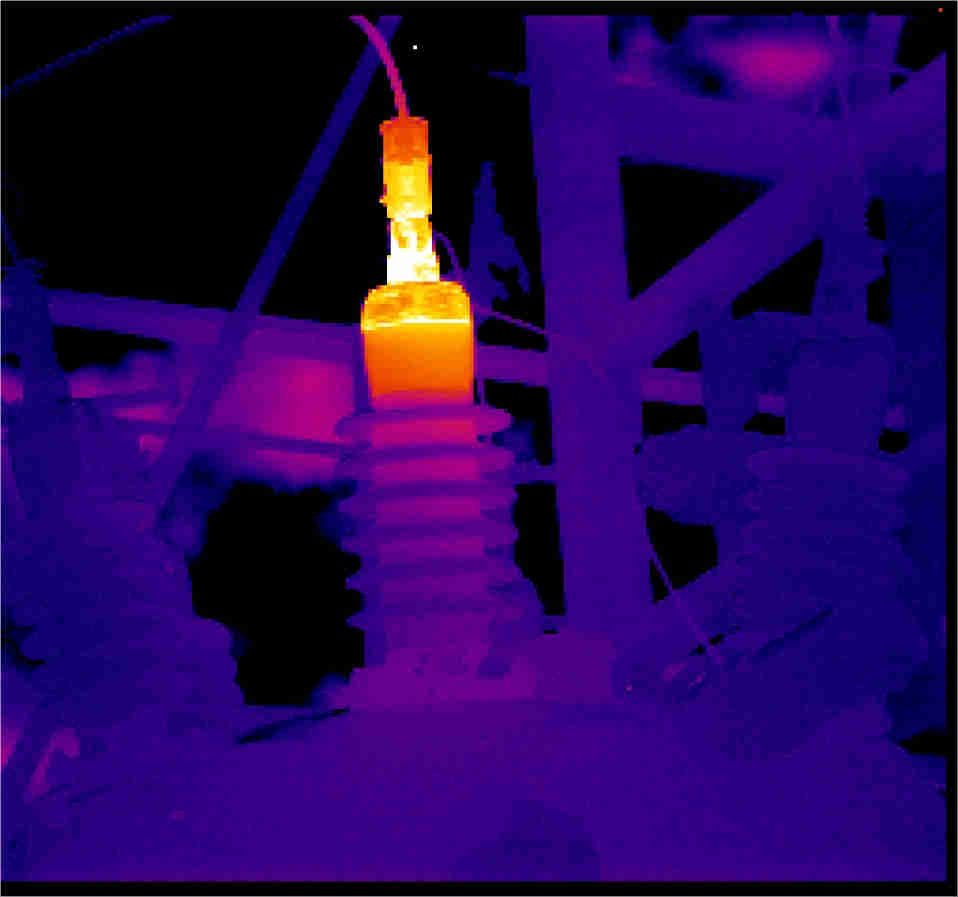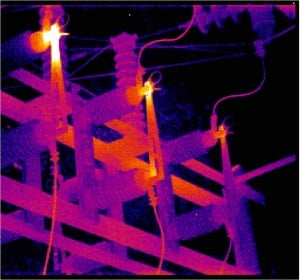Electrical substations have many complex systems that handle very high voltage. Keeping these systems running safely and efficiently is critical for utilities and their customers. A failure can result in lost power and production revenue for customers and liability issues for the utility.
 The Fluke TiX580 Infrared Camera with 240° screen rotation makes it convenient for substation inspections that span from the ground up.
The Fluke TiX580 Infrared Camera with 240° screen rotation makes it convenient for substation inspections that span from the ground up.
By identifying overheating or abnormally cool operating temperatures in substation components, electricians and maintenance technicians can isolate potential failures before they happen. The key is to focus on the most critical equipment in a substation, which, if it fails, will result in a major outage. Using a thermal camera (also known as a thermal imager) can expedite that process and help you find potential problem areas before they find you.
 The OCB bushing shows a classic signature associated with the connection in the head.
The OCB bushing shows a classic signature associated with the connection in the head.
Basic guidelines
Some of the most important issues you should address in inspecting electrical line and substation equipment include:
- Load: the system should be running at 40% or more of peak load when you inspect it, the higher the better. If you find a hot spot and loads are likely to increase during peak, pay attention to how much more heating will occur.
- Wind: if winds at the component are in excess of 10 mph (16k/h), great care should be taken to note any and all abnormal heating. That’s especially true if the winds are likely to diminish.
- Phases: unless there is a load imbalance among the three phases, all will typically function at similar temperatures. If a component on one phase is warmer than on another, make a note and determine why.
- Temperature: if you find a hotspot, don’t ignore it, even if it is small and not very hot. When you measure temperature, work well within the measurement resolution of the imager and compensate accurately for both emissivity and background.
- Temperature change: even small rises can indicate serious problems depending on conditions and the equipment. Ultimately, let the consequences of failure help drive the response rather than a predetermined temperature-based prioritization.
Where to look for hot spots
Start with the exterior of the substation using a thermal imager with a wide-angle lens. Scan the transmission line feeding the station, the circuit from the transmission line, high side insulators (arrestors) and then zero in on transformer components.
Transformers are critical to power distribution and are also very susceptible to heat-related failure. A substation transformer can cost hundreds of thousands of dollars to replace so regular inspection is essential. Key areas to inspect include:
- Bushings: Zoom in on both the external and internal connections in the bushing head and connections to the coils.
- Surge protection: Look closely at segmented signatures with small rises in temperature as indicators of serious problems
- Cooling systems: Failures in the cooling system can rapidly result in damage to the transformer. A blockage or low oil level in transformer cooling tubes will show up as cool tubes. Also, look at the fan motor housings after they have run for 15 minutes or more to see if any of them show higher heat signatures than the others.
- Tap changer tanks: Normally these run at or below the temperature of the transformer. If a bad tap is carrying load, it will heat the changer tank. Beware, the tap must be de-energized while you are inspecting it!
- Oil-filled circuit breakers (OCB) and voltage regulators are also critical to substation operations and can suffer heat-related failures like transformers.
 Four of the six primary contact points on this set of disconnects are showing abnormal heating.
Four of the six primary contact points on this set of disconnects are showing abnormal heating.
In addition, various disconnects and switches may not seem crucial, but if a circuit needs to be opened and a disconnect is welded closed, there will be a serious problem. Disconnects and switches are very susceptible to damage because localized heating in the jaw or latch end typically damages the metal and accelerates the trend to failure. Most disconnects and switches depend on the spring tension of the metal to maintain viability of the electrical contact. Annealing begins and performance degrades at temperatures as low as 200 °F (93 °C).
There is a lot of equipment to cover in a substation. Although you won’t be able to fix every problem you find, you can prioritize them, fixing those that are critical and managing the rest until repairs can be made. That approach will help you get through the peak season with improved reliability and safety.